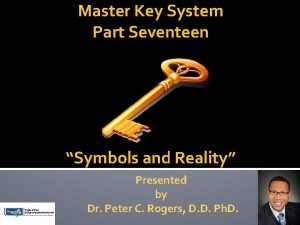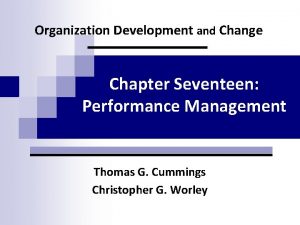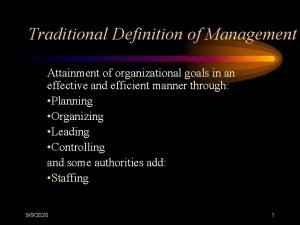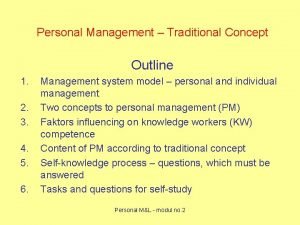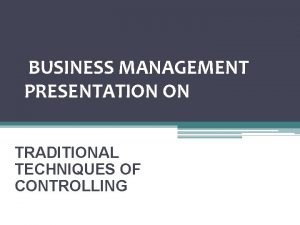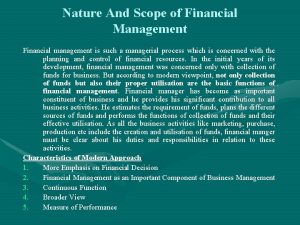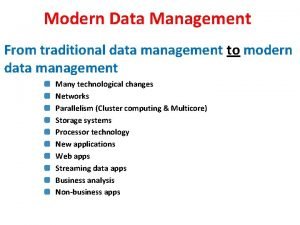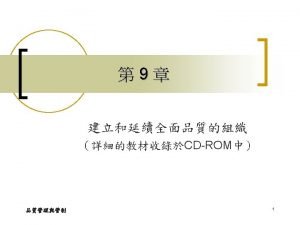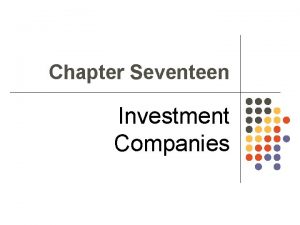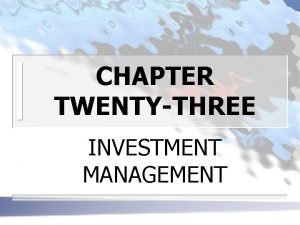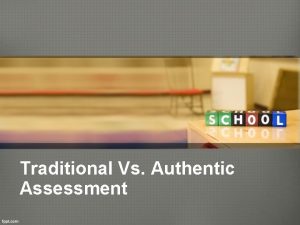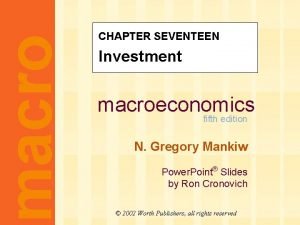CHAPTER SEVENTEEN INVESTMENT MANAGEMENT 1 INVESTMENT MANAGEMENT TRADITIONAL












- Slides: 12

CHAPTER SEVENTEEN INVESTMENT MANAGEMENT 1

INVESTMENT MANAGEMENT • TRADITIONAL INVESTMENT MANAGEMNT ORGANIZATIONS – Security Analysts play a key role and rely upon information and reports from • economists • technicians • market experts – Investment Committee is advised by the analyst to create – An Approved List of Securities 2

INVESTMENT MANAGEMENT 3

INVESTMENT MANAGEMENT FUNCTIONS • FIVE STEP PROCEDURE: – SETTING INVESTMENT POLICY – PERFORMING SECURITY ANALYSIS – CONSTRUCTING A PORTFOLIO – REVISING THE PORTFOLIO – EVALUATING THE PORTFOLIO 4

INVESTMENT MANAGEMENT FUNCTIONS • SETTING INVESTMENT POLICY – DETERMINE THE INVESTMENT OBJECTIVE • estimate the client’s level of risk tolerance 5

INVESTMENT MANAGEMENT FUNCTIONS • PERFORMING SECURITY ANALYSIS – Security Selection: A 2 Stage Procedure – STAGE I: forecast • • expected returns standard deviation covariances identify optimal portfolio 6

INVESTMENT MANAGEMENT FUNCTIONS • PERFORMING SECURITY ANALYSIS – Security Selection: A 2 Stage Procedure – STAGE II: Asset Allocation • strategic – refers to how a portfolio’s funds would be divided, given the manager’s long-term forecasts from Stage I • tactical – given short-term forecasts, who will assets be allocated at any one time 7

REVISING THE PORTFOLIO • REVISING THE PORTFOLIO – Use Cost-Benefit Analysis • transaction costs should be examined since they complicate the management decision • portfolio revisions must be weighed against the cost of revision particularly with regard to transaction costs 8

REVISING THE PORTFOLIO • REVISING THE PORTFOLIO – SWAP METHODOLOGY • a cost saving method which involves exchanges of assets rather than purchases or sales • TYPES OF SWAPS: – Equity – Interest Rate 9

REVISING THE PORTFOLIO • REVISING THE PORTFOLIO – SWAP METHODOLOGY • The Equity Swap: – The Agreement » one party agrees to pay the other a variable-sized cash payment » the other party agrees to a fixed-sized cash payment – Results in a restructured portfolio without incurring any transaction costs 10

REVISING THE PORTFOLIO • REVISING THE PORTFOLIO – SWAP METHODOLOGY • The Interest Rate Swap – The Agreement » one party pays the second a variable-sized stream of cash based on the current level of an agreed-upon interest rate (e. g. LIBOR) » second party pays the first a fixed-sized payment stream based on the interest rate at the time of the Agreement – Results in a restructured portfolio without incurring any transaction costs 11

THE MARKET FOR SWAPS • THE MARKET FOR SWAPS – The Market • Is unregulated for the most part – no government agency responsible for it – privacy – each party must pay close attention to the solvency of the other party • Swap Banks are the heart of the market – they act as dealers – arrange for creation and dissolution of agreements 12
 Dance moms seventeen magazine
Dance moms seventeen magazine Seventeen symbols
Seventeen symbols Parfoy
Parfoy Seventeen table
Seventeen table Fixed investment and inventory investment
Fixed investment and inventory investment Traditional management vs entrepreneurial management
Traditional management vs entrepreneurial management Traditional project management vs modern project management
Traditional project management vs modern project management Attainment of organizational goals
Attainment of organizational goals Traditional concept of management
Traditional concept of management Traditional management techniques
Traditional management techniques Traditional approach of finance function
Traditional approach of finance function Traditional data management
Traditional data management Traditional management definition
Traditional management definition

